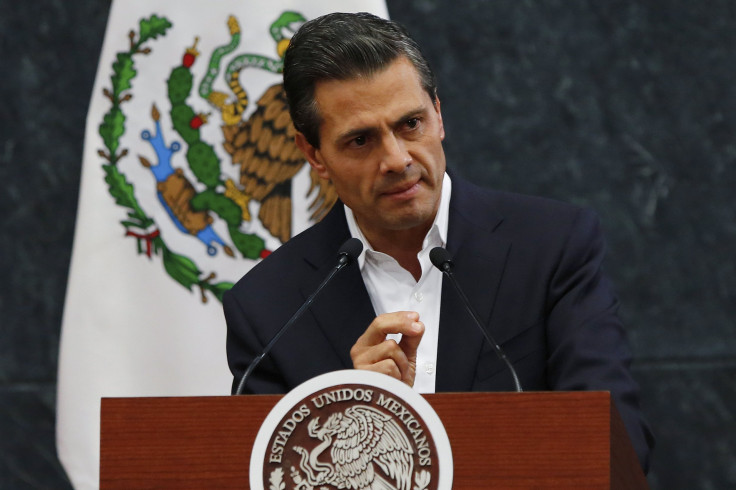Mexico Missing Students Case Highlights President Enrique Peña Nieto's Spotty Security Record

Public anger in Mexico over the ongoing search for 43 students who went missing more than a month ago has galvanized mass protests and led to the ouster of a state governor. Some of the outrage is being directed at President Enrique Peña Nieto, who promised to sharply cut violence when he took office almost two years ago. While his administration has trumpeted falling homicide rates, analysts say his security approach hasn’t produced the dramatic change he promised.
Peña Nieto offered a refreshing approach to Mexico’s festering security problem while running for the presidency in 2012. His predecessor, Felipe Calderón, had launched a military assault on the drug cartels, targeting high-level bosses, a strategy that critics say merely splintered the organizations and left volatile, smaller gangs in their wake. During his presidential campaign, Peña Nieto promised to dramatically cut the everyday violence that had spiked under Calderón’s administration, as reported by the Associated Press.
Some figures look encouraging: According to InSightCrime’s take on numbers furnished by the National Statistics Institute, homicides fell by around 12 percent in 2013, compared with the previous year. Speaking at an event at the Council on Foreign Relations last month, Peña Nieto said murders fell by 29 percent in the first half of 2014, versus the comparable period in 2012. In border states, homicide rates fell by more than 40 percent, he added.
But the National Statistics Institute also noted that despite falling homicide rates, other crimes such as extortion, kidnapping and robbery were still on the rise in 2013, the Wall Street Journal reported.
Analysts say Peña Nieto’s security record is one of mixed results. “If you look at some places that were terrible back in 2008, they’re doing much better today,” said Andrew Selee, executive vice president of the Wilson Center’s Mexico Institute. “But if you look at places like Guerrero, Tamaulipas and a few other places, the problems run very deep, and it’s not clear that they’re getting better.”
“We cannot take on a triumphalistic approach with the organized criminal activities,” the president said at the Council on Foreign Relations. “We have to reaffirm, instead, that this is a priority for my administration, that we are making progress in terms of fighting crime, and then the figures that we see are encouraging. But still, we know that we are on the right path.”
Selee said Peña Nieto’s approach to security has actually largely mirrored that of his predecessor. “In many ways, there is a lot of continuity from Calderon -- sort of the same strategy with better coordination,” he said, noting that in some places, murder rates were already on the decline before the current president even took office.
Several analysts have echoed the theme about the comparisons between Peña Nieto and Calderón on security, drawing a picture of an administration that has focused on targeting high-level criminal leaders and reacted to violence patterns instead of adopting innovative approaches to the problem. “I worry that the strategy is not driven by the administration but rather by reaction to a much larger and complex set of problems than people like Peña Nieto and politicians like him realize,” David Shirk, a security expert with the Wilson Center, said in an interview this month.
Others are also skeptical the falling homicide rates have resulted from the administration’s policies. “In my view, a vast majority of the reduction is not the outcome of policy,” said Vanda Felbab-Brown, a senior fellow at the Brookings Institution. Rather, cartels in some areas have been resettling territorial boundaries, leaving drug markets calmer in the short term, she said. “But if the market becomes disturbed again as a result of more interdiction hits, or as a result of things that are internal to the criminal market, then violence will shoot up,” she said.
And while the offensive on the cartels has produced some high-level takedowns -- including notorious drug kingpin Joaquin “El Chapo” Guzman of the Sinaloa cartel and Hector Beltran Leyva of the Beltran Leyva cartel -- much of the violence has shifted to the state and local levels, where police corruption has abounded. “In terms of producing police reforms at the state and local level, there hasn’t been any leadership,” said Alejandro Hope, a security analyst at the Mexican Institute for Competitiveness.
Meanwhile, the perceptions of widespread police corruption and insecurity have sparked outrage. “The administration assumed things were getting better in terms of public security, and that by coordinating better they would continue to make progress,” Selee said. “They focused their energies on economic and energy reforms that they had promised the country. They’ve been surprised by how bad things are still in places like Guerrero [the state where the missing students were last seen].”
“They misdiagnosed the problem initially,” Hope said. “[The administration] seemed to think that the problem of violence in Mexico was mostly an issue of political skills, that if you could just bring everyone to the table and treat everyone with due respect, everyone would do their jobs. But that theory has been completely blown out of the water with recent events.”
Many Mexicans are calling on the administration to adopt a bold new approach to combat violence and impunity, but the president hasn’t yet signaled any major changes ahead. “What I would like to see is not just doing more of what’s been done, but adopting different policies, thinking differently about interdiction, going into some of the areas which seem to be settled but where more work needs to take place,” Felbab-Brown said. “I’m not persuaded that recent events will force the administration to do that.”
© Copyright IBTimes 2024. All rights reserved.






















